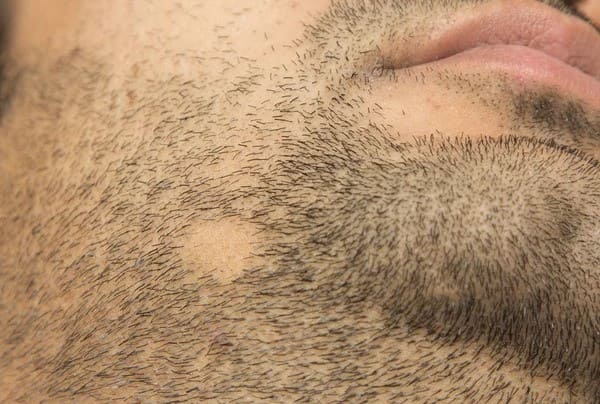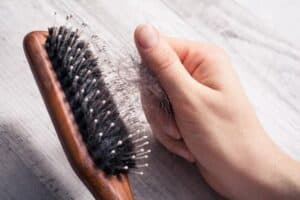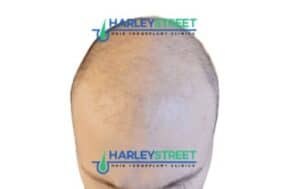Are you suffering with alopecia barbae? Look no further! On this page, you will find everything you need to know about alopecia barbae, including: hair loss symptoms, getting a diagnosis, other forms of alopecia and the treatment options at your disposal.
Alopecia Barbae Overview
Alopecia barbae is an autoimmune disease that affects a person’s facial hair, leaving them with patchy hair loss. Usually temporary, patients with an alopecia barbae diagnosis will see their hair grow back at some point. There are several treatment options to help speed up hair regrowth.
What is Alopecia Barbae?
If you’re suffering from hair loss in the beard area, then you have probably come across a condition called “alopecia barbae”. This autoimmune disease specifically affects facial hair, leaving patients with patchy hair loss in the size of a 10p to 50p piece.
Alopecia barbae affects roughly 2 in 100 people across the globe. Although rare, this condition can leave many sufferers feeling self-conscious and worried about their appearance. This condition is very similar to another condition called alopecia areata, which affects 160 million people across the globe.
Symptoms of alopecia barbae are most common in the jawline area, giving an appearance of small circular patches along the jawline. Alopecia barbae can also be present in the cheek, sideburn, and under the mouth.
Alopecia Barbae Causes
As alopecia barbae is an autoimmune disease, this means hair loss is caused when the body’s white blood cells attack the beard hair follicles. The same is also true for alopecia areata, but only affecting the scalp hair follicles.
Although there is no definitive research, scientists believe this autoimmune response is triggered by the collapse of a person’s immune privilege around the beard hair follicles. “Immune privilege” is the body’s ability to coincide with certain pathogens without provoking an inflammatory (or defensive) response. So, losing this privilege causes a person to lose hair.
The exact mechanism that causes immune privilege collapse within the beard hair follicles isn’t fully clear. However, some researchers believe it’s due to a lack or failure of regulatory T-cells (white blood cells responsible for fighting disease). As such, the immune system mistakenly attacks its own hair follicles, leading to temporary hair loss.
Other alopecia barbae causes include psychological/physical stress and genetic factors.
Do Other Autoimmune Disorders Put Me at Risk of Alopecia Barbae?
According to some research (Thomas, 2008), alopecia areata and barbae have been seen in patients with other autoimmune disorders such as: vitiligo, lichen planus, morphea, pemphigus foliaceus, atopic dermatitis, Hashimoto’s thyroiditis, thyroid disorders, endemic goiter, Addison’s disease, pernicious anemia, lupus erythematosus, and others.
Although it is not certain whether having an autoimmune disorder will cause you to have alopecia barbae, if you think you may be suffering from bald patches then be sure to contact your doctor or GP.
Symptoms of Alopecia Barbae
So, how do you spot alopecia barbae? Unlike other hair loss conditions like male pattern baldness, alopecia barbae is easy to spot as the condition manifests quickly and distinctly.
Whilst conditions like pattern baldness or diffuse alopecia will occur gradually and in a patterned manner (usually affecting a receding hairline and then the crown area), alopecia barbae will develop quickly and be immediately noticeable.
Alopecia barbae will cause bald patches (concentrated hair loss) in the beard area. In most cases, the size of these patches of hair loss is between a 10p and 50p piece.
It is not uncommon for more than one hair loss site to occur. So, if you’re seeing multiple bald patches on the beard, then you are probably developing alopecia barbae.
What is the Difference Between Alopecia Barbae and Alopecia Areata?
Strictly speaking, alopecia barbae is a smaller sub-condition of the autoimmune disease alopecia areata. Whilst Alopecia areata can affect the entire scalp, alopecia barbae only affects the beard and moustache.
Whilst men and women can suffer from alopecia areata, only people assigned male at birth suffer from alopecia barbae. If a patient suffers from both alopecia barbae and areata, this condition would be called “alopecia totalis”, leaving patients bald on the scalp and beard.
Does Alopecia Barbae Cause Permanent Hair Loss?
No, alopecia barbae and alopecia areata are not permanent hair loss conditions. This means your hair loss will only be temporary. This usually occurs for between 3-6 weeks, before your beard hair will begin regrowing.
During this time, those experiencing beard alopecia will simply need to wait for the immune system response to subside, enabling new hair growth.
Although only temporary, a sufferer may see alopecia barbae occur multiple times throughout their life. Anecdotal evidence from patients who have had consultations with us has shown the condition can flare up during stressful periods.
Alopecia Barbae Treatments
Treating alopecia barbae does require some nuance and research. As alopecia barbae and alopecia areata are only temporary hair loss conditions, hair transplants are not a viable option. Unfortunately, there is no cure for alopecia barbae. However, it is a manageable condition.
So, how can a person treat alopecia barbae?
Topical Treatment
One way in which sufferers can treat alopecia barbae is through the use of a topical treatment like minoxidil for hair loss. Most commonly used to treat androgenetic alopecia (pattern baldness), minoxidil can also be used to treat beard hair loss.
Minoxidil works by increasing the blood flow around the beard hair follicles. This helps to provide the follicle root with plenty of oxygen and promote hair growth in the beard. Although this is unlikely to stop the beard hair loss, it will help patients regrow their beard hair.
Micro-needling
Another way to help treat beard hair loss is to use a micro-needling treatment in conjunction with minoxidil. Like minoxidil, micro-needling aims to increase blood flow around the beard area, helping the facial hair follicle root. With more nutrients, this can help to stimulate new hair follicles.
Shave your Facial Hair
Although this is by no means an alopecia beard treatment, this can help to limit signs to other people that you are suffering from this condition. Keeping clean shaved every couple of days will help cover any signs of bald spots, improving your self-confidence.
If you are suffering with extensive hair loss in the beard, then this may be a wise option until your beard hair begins to grow back.
Why Can a Patient Not Have a Beard Hair Transplant With Alopecia Barbae?
Unfortunately, patients with alopecia barbae are unable to have a beard transplant. The same is true with alopecia areata sufferers and hair transplants. A facial hair transplant is impossible for three reasons.
First, alopecia areata (barbae) is only a temporary form of hair loss. The hair follicles lost during a flare-up will eventually regrow, negating the need for a hair transplant. For this reason, a beard transplant would be a waste of money, as 3-6 months after your condition, your facial hair will be back to normal.
Second, beard alopecia areata can occur on more than one occasion. If a patient were to have a beard transplant in the area where they had a flare-up, the condition may reoccur in the future, making surgery a pointless endeavour.
Finally, as alopecia areata (barbae) is an autoimmune disease, there is a high likelihood that the grafts implanted during an FUE procedure would be rejected and shed. This means the only way of treating alopecia barbae is to wait and use topical treatments and micro-needling to encourage new hair growth.
Conclusion
Beard alopecia areata (alopecia barbae) can be a troubling condition for any man to suffer from. Although the condition only causes temporary flare-ups, how this manifests as a patchy beard can be upsetting, causing many men to feel self-conscious.
Although there is no cure or long-term treatment for alopecia barbae, this condition usually resolves itself within a few weeks. Despite treatment not being necessary, some people experiencing this condition to try treatments such as micro-needling and minoxidil.








